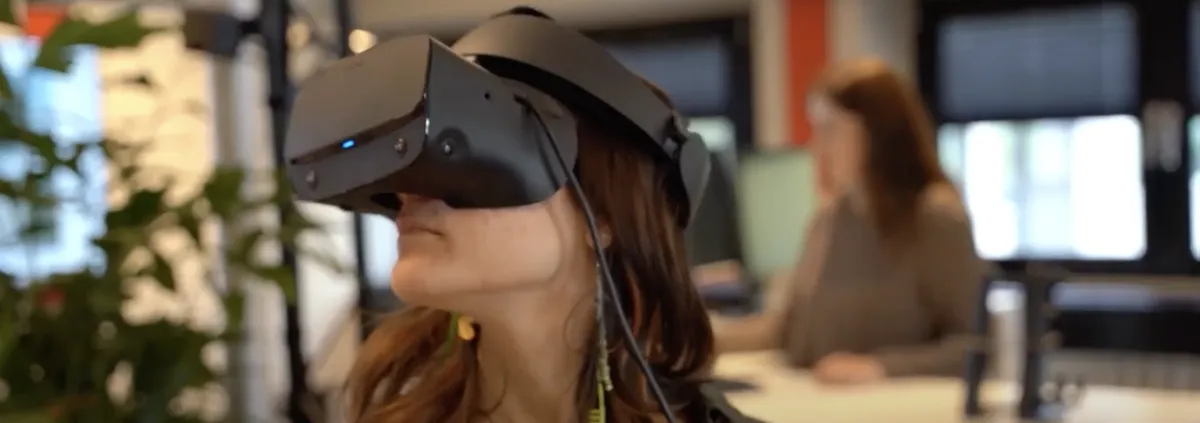|
Level: Intermediate Setting: Non-formal Format: In-person Subjects: Citizenship education |
As educators, we're always looking for new ways to captivate students and help them understand complex issues like climate change. Our project uses the exciting potential of immersive virtual reality (VR) to transform climate education. This approach can be integrated into all educational levels and lifelong learning.
We designed culture-specific VR simulations that depict future climate change scenarios for the Netherlands and for Turkiye, such as rising sea levels and draught. By experiencing these potential impacts on communities and ecosystems firsthand, learners gain a tangible and emotionally engaging understanding of climate change.
Unlike traditional media, VR offers an interactive and emotionally powerful experience. By using realistic human avatars who share personal stories, VR simulations help participants feel the urgency of climate change. This enhanced immersion increases certainty about climate change, reduces skepticism, and fosters a deeper emotional connection to the issue.

How can Immersive VR Experiences Help Enhancing Climate Change Behavior and Belief?
1. Engaging and Interactive: VR’s 360-degree, interactive environments make learners feel as though they are truly present in the scenarios. This immersive experience promotes problem-solving, critical thinking, and practical application, making learning both enjoyable and meaningful.
2. Emotional Connection: Human avatars in VR help participants relate more closely to the effects of climate change, boosting empathy and emotional engagement. This connection can lead to significant changes in attitudes and behaviors.
3. Lasting Impact: Research shows that VR can influence beliefs and attitudes about climate change. Participants exposed to VR gained increased certainty about climate change, reduced skepticism about its impacts, and recognized human activity as a significant factor.
4. Encouraging Positive Behavior: Ongoing studies suggest that VR can also motivate pro-social behaviors, such as donating, volunteering, and reducing littering, by strengthening the emotional connection to environmental issues.
Methodology
To evaluate how immersive technology can fight climate change misinformation, we conducted a study comparing Virtual Reality (VR) to traditional social media platforms. Our participants, aged 18-65 and not sensitive to motion, included university students, faculty, administrative personnel, and members of the broader community. This diverse group took part in an experiment aimed at correcting misconceptions about climate change. By combining interactive technology with emotional storytelling, our approach aims to bridge the gap between information and understanding.
In the VR scenario, participants wore headsets that transported them into vivid simulations of rising sea levels and drought-affected farmlands. Imagine standing in a coastal community, witnessing homes being swept away by floods or watching crops wither under the relentless sun. These scenarios weren’t just visually immersive—they were emotionally powerful, helping participants feel the gravity of climate change impacts. Some participants read messages about the human causes of climate change, while others listened to lifelike avatars deliver the same message. The interactive nature of VR—complete with “like,” “share,” and “dislike” buttons—mirrored familiar social media interfaces, making the experience both engaging and impactful.

We also tested a social media-based scenario, where participants interacted with "The Misinformation Game," a platform adapted to display posts spreading climate misinformation. They saw claims like “Climate change is a natural occurrence” and were presented with corrections alongside snapshots from the VR simulations. This allowed them to compare traditional text-based corrections with the rich, emotional context VR provides.
By integrating emotionally charged experiences and interactive elements, our study sought to assess whether VR could offer a more powerful, lasting correction to climate change misinformation. The results from both VR and social media-based interventions were tracked through surveys and even psycho-physiological measures, such as heart rate, to gauge emotional responses.
This blend of technology and emotional engagement offers an innovative way to foster not just understanding, but also empathy, certainty, and a willingness to take action on climate change.
Findings on the Use of Human Avatars
Conveying climate change information through avatars representing individuals directly affected by rising sea levels and drought had a profound impact on participants' belief systems. The use of these avatars heightened emotional engagement, allowing participants to empathize deeply with the experiences portrayed. This emotional connection was not only reflected in the participants' self-reported attitudes but was also evident through physiological measures such as increased heart rates, indicating a stronger emotional response. This heightened emotional affection played a key role in shifting beliefs about climate change, making the immersive VR experience more effective than traditional methods.
Integrating VR into Education:
Our approach is rooted in experiential learning. By immersing learners in VR environments, we offer guided exploration and reflection, allowing them to see the real-world impact of their decisions and understand climate scenarios in a meaningful way.
This innovative method supports lifelong learning in environmental skills, making climate education more effective and accessible. It empowers individuals to take informed environmental actions and bridges the gap between awareness and action.
See It for Yourself:
To get a sense of the VR experience, check out some screenshots showcasing scenes from our VR environment. This visual highlights how immersive simulations can vividly bring climate change to life and make a lasting impact on learners.

In summary, our VR project represents a major advancement in climate education, offering a dynamic and engaging tool with the potential to change attitudes and behaviors. By incorporating VR into educational settings, we can deepen understanding of climate change and inspire meaningful action.

Explore the future of climate education with us. Together, we can make a difference.
For more details on how VR can transform climate education, feel free to reach out or learn more about our project.
Colaborators: Funda Yildirim, Elif Erişen, Emirhan Duran, Batuhan Şar, Irmak Kalkan


Thank you!